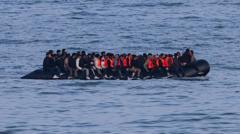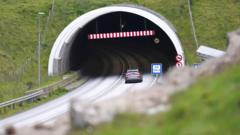**The tunnel promises to drastically reduce travel times while promoting environmental sustainability.**
**Historic Undersea Tunnel Set to Transform Links Between Denmark and Germany**

**Historic Undersea Tunnel Set to Transform Links Between Denmark and Germany**
**A groundbreaking project will create the world's longest pre-fabricated road and rail tunnel beneath the Baltic Sea.**
A remarkable engineering project is currently underway: a record-breaking tunnel beneath the Baltic Sea connecting Denmark and Germany. The Fehmarnbelt tunnel, stretching an impressive 18 kilometers (11 miles), is set to become the world’s longest pre-fabricated tunnel, significantly enhancing travel links between Scandinavia and central Europe.
This ambitious infrastructure venture is based off the coast of Lolland, Denmark, where a sprawling construction facility is busy crafting the tunnel segments. As reported by Henrik Vincentsen, chief executive of Femern, the state-owned company responsible for the project, the facility spans over 500 hectares (1,235 acres) and includes both a harbor and a manufacturing site.
The concrete segments, known as “elements,” are designed using reinforced steel and impressive engineering techniques. Unlike traditional underwater tunnels that burrow through the seafloor, this construction will use 90 interlocking segments placed directly on the seabed. Mr. Vincentsen emphasizes that this unprecedented scale of immersion sets the project apart: "Immersed tunnels have been built before, but never on this scale."
With a cost projection of around €7.4 billion ($8.1 billion; £6.3 billion), the tunnel is mainly financed by Denmark, supplemented with €1.3 billion from the European Commission as part of a plan to enhance travel connections across Europe while promoting greener transportation solutions. Once operational, motorists will be able to traverse between Rødbyhavn in Denmark and Puttgarten in Germany in a mere 10 minutes, supplanting the current 45-minute ferry service. Moreover, the new rail link is expected to cut travel time between Copenhagen and Hamburg by half.
Mr. Vincentsen articulates the broader significance of this infrastructure project: "It’s not just linking Denmark and Germany; it’s creating a vital connection for all of Scandinavia with central Europe." The tunnel also addresses concerns over environmental impact, as the project aims to replace trips that often contribute to carbon emissions with more efficient transit options.
The tunnel project is a complex undertaking, involving careful management of underwater logistics where elements weighing over 73,000 tonnes are submerged and aligned with precision. A team is meticulously deploying “pin and catch” techniques to ensure the components are fitted flawlessly into their designated trenches.
Since its inception, the project has faced opposition, particularly from regional conservationists concerned about the ecological ramifications on the Baltic Sea's delicate ecosystem. Despite delays caused by these objections, a federal court in Germany ultimately allowed construction to move forward, and efforts to mitigate environmental impacts are in place.
Set to be completed by 2029, Femern anticipates that the tunnel will accommodate over 100 trains and 12,000 vehicles daily, with user fees projected to fund the state-backed loans for the construction. As the local population of Lolland, one of Denmark's economically challenged regions, eagerly awaits the influx of business and tourism spurred by the project, construction teams remain focused on turning this ambitious vision into reality.
As stated by Mr. Wede, a senior construction manager involved in the project, “The locals down here have been waiting for this project for a lot of years… They’re looking forward to businesses coming to the area.”





















